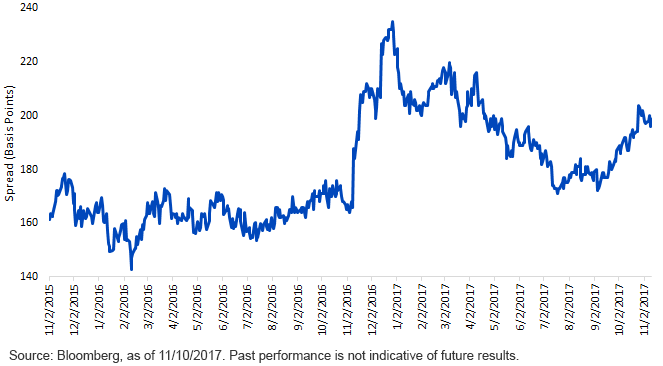U.S. Treasuries: The Fourth Element
Thus far, 2017 has proved to be somewhat of a vexing year for investors expecting to see a higher U.S. rate environment. While the Federal Reserve (Fed) has delivered on its front by pushing up short-term interest rates, longer-dated yields such as the U.S. Treasury (UST) 10-Year note have not followed suit. I like to think of developments for the UST 10-Year yield as a three-legged stool consisting of the “Trump reflation trade,” inflation expectations and the Fed policy outlook. However, there is a fourth element that has gone a bit under the radar, and that is the continued yield advantage UST securities enjoy as compared to their developed world counterparts, namely the German bund.
Certainly, when the UST 10-Year yield was falling to all-time lows in mid-2016, the general consensus was that this yield advantage was playing an integral role—namely that global investors were buying Treasuries over other developed world government debt. Then a funny thing happened: the U.S. election, which led to all three legs of the aforementioned “stool”’ working to push the UST 10-Year yield higher. Another key aspect that occurred simultaneously was that the spread between the 10-Year UST and the 10-year bund widened even further, moving out to readings not seen since 1989. However, unlike the pre-election experience, this “new” and even more favorable yield advantage was essentially being ignored.
U.S. 10-Year vs. 10-Year German Bund

It may have taken global bond investors awhile, but it appears as if this factor is, once again, playing an important role in the latest UST 10-Year yield developments. Despite the fact that there have been reports of outflows in longer-dated Treasuries, UST yields have managed to stay in a range of roughly 10 to 15 basis points (bps) over the last month or so. After reaching a recent peak of +235 bps in late December, the UST/German bund 10-year spread narrowed by more than 60 bps in late summer but has since reversed course and pushed upward to the +200 bp threshold of late. At this level, the differential is now nearly 60 bps above the two-year low water mark and has apparently spurred bond investors into action.
Conclusion
As we move closer to year-end and receive additional headlines regarding the tax reform/cut debate, it seems reasonable to expect UST 10-Year yields to respond to such news. In fact, one could argue that passage of tax-related legislation (that is not watered down and could add to the budget deficit) would more than likely be viewed as a negative development for interest-sensitive fixed income instruments, carrying the potential to push longer-dated rates toward the upper end of the trading band. However, in my opinion, the relative yield advantage phenomenon could still be a force to consider, especially considering the European Central Bank’s recent decision to continue its QE program through September 2018. As fixed income investors have witnessed thus far in 2017, this factor could continue to act as a “cap” on where UST 10-Year yields will ultimately go.
Unless otherwise noted, data source is Bloomberg, as of November 10, 2017.
Disclaimer: Investors should carefully consider the investment objectives, risks, charges and expenses of the Funds before investing. U.S. investors only: To obtain a prospectus containing this ...
more


